NCERT Solutions for Class 10 Science Chapter Chapter 11 Electricity includes answers to intext & exercise questions. All these NCERT solutions are prepared by expert teachers with detailed explanations of every important topic. It is important for the students to go through these NCERT solutions to get knowledge of the type of questions asked in the Electricity chapter.
NCERT Solutions for Class 10 Science Chapter 11 Intext Questions
Page No. 172
Question 1: What does an electric circuit mean?
Answer: An electric circuit is a pathway that allows electric current to flow through it. It’s made up of various electrical components like wires, a power source (like a battery), switches and devices like light bulbs or motors.
Question 2: Define the unit of current.
Answer: The SI unit of current is ampere (A).
Definition of ampere: When one-coulomb charge flows through an electric device in a circuit in one second, then the current flowing through the device is said to be one ampere.

Small quantities of current are expressed in the milliampere or in microampere
1 mA = 10-3A
1 µA = 10-6A
Question 3: Calculate the number of electrons constituting one coulomb of charge.
Answer: Charge on one electron, 𝑒 = 1.6 × 10−19 C

Page No. 174
Question 1: Name a device that helps to maintain a potential difference across a conductor.
Answer: Cell or battery maintain potential difference across a conductor.
Question 2: What is meant by saying that the potential difference between two points is 1 V?
Answer: Potential difference between two points in a circuit is defined as work done or energy required in moving one coulomb of charge from one point to the other. If the potential difference is 1 V, the energy required to move one coulomb of charge from one point to the other is 1 J.
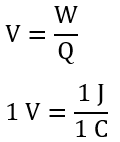
Question 3: How much energy is given to each coulomb of charge passing through a 6 V battery?
Answer: Potential difference created by battery ΔV = 6 V
Potential difference between two points in a circuit is defined as energy required (or work done) in moving one coulomb of charge from one point to the other.

So, Work done = Potential difference × Charge
= 6 Volt × 1 Coulomb
= 6 Joules
Page No. 181
Question 1: On what factors does the resistance of a conductor depend?
Answer 1: The resistance of a resistor depends on
- Properties of the material of conductor, or resistivity of a material
- Length of conductor
- Area of cross-section of the conductor
- The resistivity of a material depends on temperature. Therefore, the resistance of a resistor also depends on the temperature of the conductor.
Question 2: Will current flow more easily through a thick wire or a thin wire of the same material, when connected to the same source? Why?
Answer: Resistance of a conductor depends on resistivity 𝜌, length 𝑙 and on the area of cross-section 𝐴 as
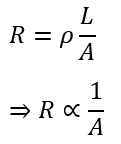
∴ When connected to the same power source, current through thick wire is more compared to thin wire of same material.
Question 3: Let the resistance of an electrical component remains constant while the potential difference across the two ends of the component decreases to half of its former value. What change will occur in the current through it?
Answer: From Ohm’s law,
V = IR
⇒ V ∝ I
If the potential difference is decreased to half the original value keeping the resistance constant, current through the electric component also decreases to half the original value.
Question 4: Why are coils of electric toasters and electric irons made of an alloy rather than a pure metal?
Answer: The resistivity of an alloy is generally higher than that of its constituent metals. Alloys do not oxidize (burn) readily at high temperatures. For this reason, they are commonly used in electrical heating devices, like electric iron, toasters etc.
Question 5: Use the data in Table 12.2 to answer the following –
Table 12.2 Electrical resistivity of some substances at 20°C
(a) Which among iron and mercury is a better conductor?
(b) Which material is the best conductor?
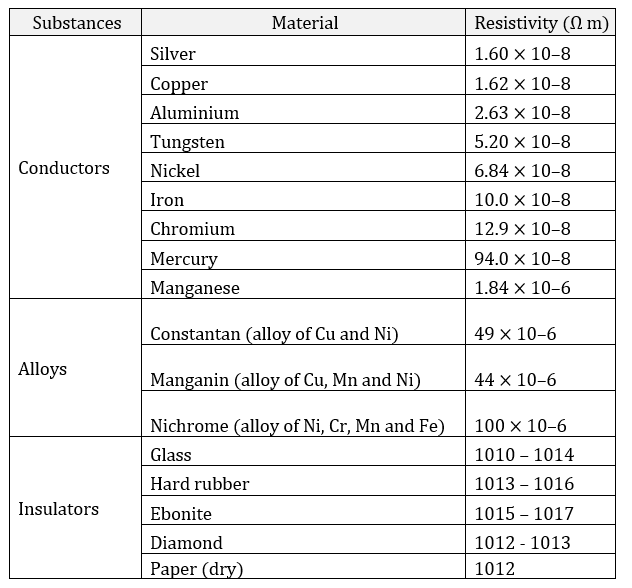
Answer 5: Conductivity of iron is 10.0 × 10-8 Ω m whereas conductivity of mercury is 94.0 × 10–8 Ω m. Therefore, iron is good conductor compared to mercury.
From the table, silver with resistivity 1.60 × 10–8 Ω m is best conductor compared to other materials given.
Page No. 185
Question 1: Draw a schematic diagram of a circuit consisting of a battery of three cells of 2 V each, a 5 Ω resistor, an 8 Ω resistor, and a 12 Ω resistor, and a plug key, all connected in series.
Answer:
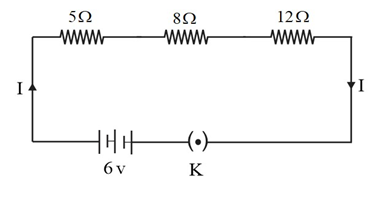
Question 2: Redraw the circuit of Question 1, putting in an ammeter to measure the current through the resistors and a voltmeter to measure the potential difference across the 12 Ω resistor. What would be the readings in the ammeter and the voltmeter?
Answer:
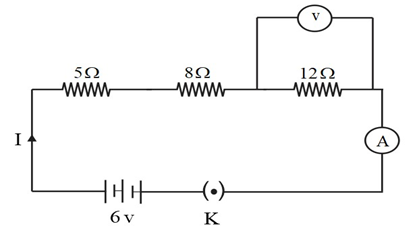
Resisters are connected in series.
So, the net resistance in the circuit = 5 Ω + 8 Ω + 12 Ω = 25 Ω
Net potential = 6 V

Now for the 12 Ω resistor, current = 0.24 A
So, using Ohm’s law V = 0.24 × 12 V = 2.88 V
Hence, the reading in the ammeter is 0.24 and voltmeter is 2.88.
Page No. 188
Question 1: Judge the equivalent resistance when the following are connected in parallel –
(a) 1 Ω and Ω,
(b) 1 Ω and Ω, and Ω.
Answer: When 1 Ω and Ω are connected in parallel, equivalent resistance

When 1 Ω, Ω, and Ω are connected in parallel
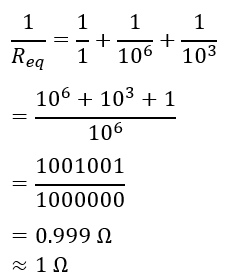
From the above two problems, when very low resistance is connected to very high resistance, the resistance of the combination will be close to low resistance.
Question 2: An electric lamp of 100 Ω, a toaster of resistance 50 Ω, and a water filter of resistance 500 Ω are connected in parallel to a 220 V source. What is the resistance of an electric iron connected to the same source that takes as much current as all three appliances, and what is the current through it?
Answer:
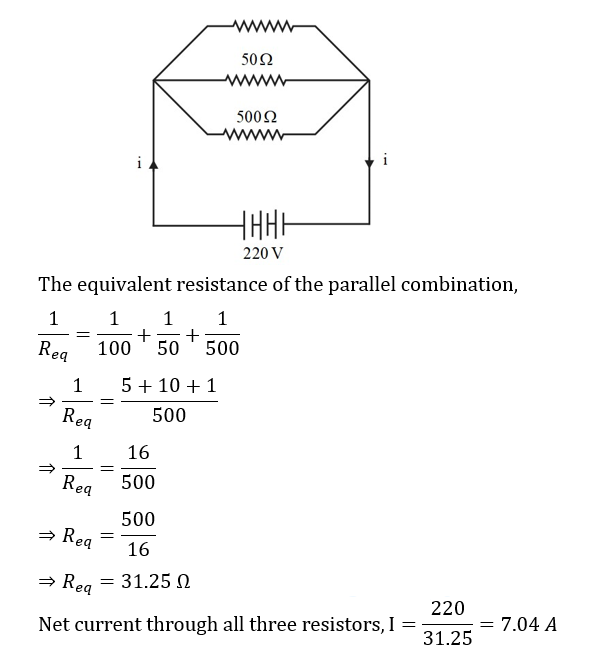
To draw the same current resistance of electric iron required is 31.25 Ω and current through it is 7.04 A.
Question 3: What are the advantages of connecting electrical devices in parallel with the battery instead of connecting them in series?
Answer:
| Parallel Connection | Series Connection |
|---|---|
| Each device gets the same constant voltage. | Voltage is divided among the devices. |
| If one device fails, others continue to work. | If one device fails, the entire circuit can stop working. |
| Easy to add or remove devices without affecting others. | Adding or removing devices affects the whole circuit. |
| Reduced risk of overloading; better load distribution among devices. | Load distribution can be uneven; some devices might be overloaded. |
Question 4: How can three resistors of resistances 2 Ω, 3 Ω, and 6 Ω be connected to give a total resistance of (a) 4 Ω, (b) 1 Ω?
Answer: Case 1: When all resistors are connected in series, the equivalent resistance is

Req = 2 + 3 + 6 = 11 Ω
Case 2: When all resistors are connected in parallel, the equivalent resistance is,
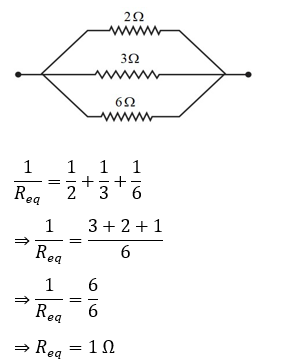
Case 3: When 2 Ω, 3 Ω are in series and 6 Ω is in parallel, the equivalent resistance is

Case 4: When 3 Ω and 6 Ω are in parallel and 2 Ω is in series, the equivalent resistance is

Thus, to get 4 Ω; 3 Ω and 6 Ω are connected in parallel and then 2 Ω is connected in series to this combination and to get 1 Ω all three resistors are connected in parallel.
Question 5: What is (a) the highest, (b) the lowest total resistance that can be secured by combinations of four coils of resistance 4 Ω, 8 Ω, 12 Ω, 24 Ω?
Answer: Highest resistance is possible when all resistors are connected in series.

R = 4 Ω + 8 Ω + 12 Ω + 24 Ω = 48 Ω
∴ highest resistance possible is 48 Ω
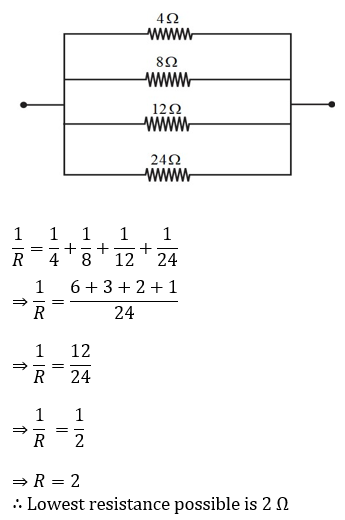
Lowest resistance is possible when all resistors are connected in parallel
∴ Lowest resistance possible is 2 Ω
Page No. 190
Question 1: Why does the cord of an electric heater not glow while the heating element does?
Answer: When the same current flows through the conducting wire and heating element, the heat generated in them is given by I2Rt. The cord of an electric heater doesn’t glow because it’s made of a material with low electrical resistance, like copper, which efficiently conducts electricity without heating up much. On the other hand, the heating element is made of a high-resistance material, like nichrome, which heats up and glows as electricity passes through it. This difference in resistance is why the heating element is designed to generate heat, while the cord simply conducts electricity safely.
Question 2: Compute the heat generated while transferring 96000 coulombs of charge in one hour through a potential difference of 50 V.
Answer: From Joule’s law of heating, the heat generated can be written as

Therefore, the heat generated when 96000 coulomb of charge flows through a potential difference of 50 V is 4.8 × 106 J.
Question 3: An electric iron of resistance 20 Ω takes a current of 5 A. Calculate the heat developed in 30 s.
Answer: From Joule’s law of heating, the heat generated can be written as
H = 𝑉 × 𝐼 × 𝑡
= I2 × 𝑅 × 𝑡
= (5)2 A × 20 V × 30 s
= 15000 J
= 15 × 103 J
Therefore, the heat generated in 30 s is 15 × 103 J
Page No. 192
Question 1: What determines the rate at which energy is delivered by a current?
Answer: The rate at which energy is delivered is the power of the electric appliance.
Question 2: An electric motor takes 5 A from a 220 V line. Determine the power of the motor and the energy consumed in 2 h.
Answer: Power of the motor, 𝑃= 𝑉𝐼 = 220 V × 5 A = 1100 W
Energy consumed in 2 hours,
𝐸 = 𝑃× 𝑡
= 1100 × 2 × 60 × 60
= 7920000 J
NCERT Solutions for Class 10 Science Chapter 11 Exercise Questions
Question 1: A piece of wire of resistance R is cut into five equal parts. These parts are then connected in parallel. If the equivalent resistance of this combination is R′, then the ratio R/R′ is –

Answer: (d) 25
Resistance of a piece of wire is directly proportional to its length.
R ∝ l
If the piece of wire has a resistance R and the wire is cut into five equal parts.
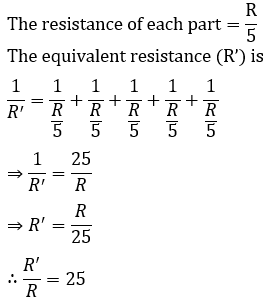
Hence, the option (d) is correct.
Question 2: Which of the following terms does not represent electrical power in a circuit?
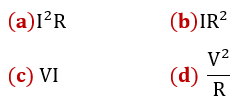
Answer: (b) IR2
We know that electric power is given by P = VI … (i)
We have from Ohm’s law, V = IR…(ii)
Now putting the value of V from (ii) in (i), we get
Power P = (IR) × I = I2 R
Hence, the option (b) does not represent electrical power in a circuit.
Question 3: An electric bulb is rated 220 V and 100 W. When it is operated on 110 V, the power consumed will be –
(a) 100 w
(b) 75 w
(c) 50 w
(d) 25 w
Answer: (d) 25 w
Energy consumed by bulb
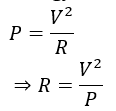
Here, V = 220 V and P = 100 W

The resistance of the bulb remains constant if the supply voltage is reduced to 110 V. If the bulb is operated on 110 V, then the energy consumed by it is given by the expression for power

Hence, the option (d) is correct.
Question 4: Two conducting wires of the same material and of equal lengths and equal diameters are first connected in series and then parallel in a circuit across the same potential difference. The ratio of heat produced in series and parallel combinations would be –
(a) 1:2
(b) 2:1
(c) 1:4
(d) 4:1
Answer: (c) 1:4
Heat produced in the circuit is inversely proportional to the resistance R.
Let RS and RP be the equivalent resistances of the wires if connected in series and parallel respectively.
Let R be the resistance of each wire.
If the resistors are connected in parallel, the net resistance is given by
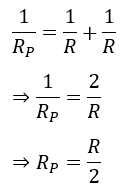
If the resistors are connected in series, the net resistance is given by
Rs = R + R = 2R
Hence, for same potential difference V, the ratio of heat produced in the circuit is given by
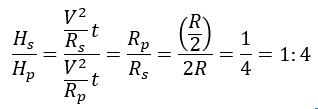
Therefore, the ratio of heat produced in series and parallel combinations is 1:4.
Hence, the option (c) is correct.
Question 5: How is a voltmeter connected in the circuit to measure the potential difference between two points?
Answer: Voltmeter is always connected in parallel with circuit element to measure the potential difference across it.
Question 6: A copper wire has a diameter 0.5 mm and resistivity of 1.6 × 10–8 Ω m. What will be the length of this wire to make its resistance 10 Ω? How much does the resistance change if the diameter is doubled?
Answer: Resistance (R) of a copper wire of length l and cross-section A is given by the expression,
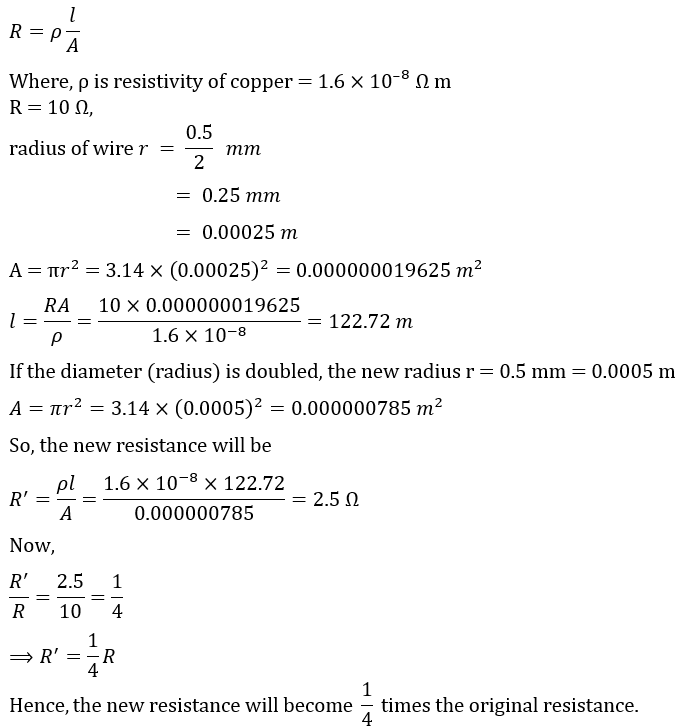
Question 7: The values of current flowing in a given resistor for the corresponding values of potential difference 𝑉 across the resistor are given below –
| I (amperes) | 0.5 | 1.0 | 2.0 | 3.0 | 4.0 |
| V (volts) | 1.6 | 3.4 | 6.7 | 10.2 | 13.2 |
Plot a graph between 𝑉 and 𝐼 and calculate the resistance of that resistor.
Answer:
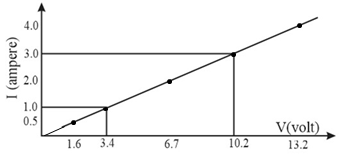
The plot between voltage and current is called VI characteristic. The voltage is plotted on x-axis and current is plotted on y-axis.
We have from Ohm’s law V = IR
The slope of the line gives the value of resistance (R)
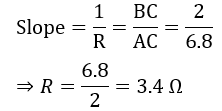
Question 8: When a 12 V battery is connected across an unknown resistor, there is a current of 2.5 mA in the circuit. Find the value of the resistance of the resistor.
Answer: From Ohm’s law,
V = IR
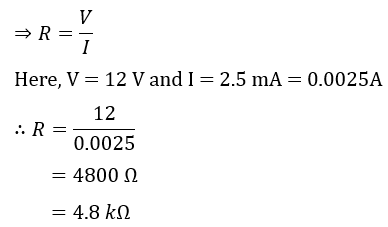
Question 9: A battery of 9 V is connected in series with resistors of 0.2 Ω, 0.3 Ω, 0.4 Ω, 0.5 Ω and 12 Ω, respectively. How much current would flow through the 12 Ω resistor?
Answer: In series combination current through all the resistors will be the same.
The resistance of resistors when connected in series is given by
Req = 0.2 + 0.3 + 0.4 + 0.5 + 12 = 13.4 Ω
Now, V = IR

So, the current through the 12 Ω resistor will be same as 0.67 A.
Question 10: How many 176 Ω resistors (in parallel) are required to carry 5 A on a 220 V line?
Answer: Let the required number of resistors be 𝑛.
Given, Current I = 5A and Potential difference V = 220V
Now, from Ohm’s law, V = IR

Now for 𝑛 number of resistors of resistance 176 Ω, the equivalent resistance of the resistors connected in parallel is 44 Ω
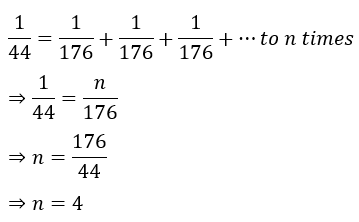
Therefore 4 resistors of 176 Ω are required to draw 5 A current on 220 V line.
Question 11: Show how you would connect three resistors, each of resistance 6 Ω so that the combination has a resistance of (i) 9 Ω, (ii) 4 Ω.
Answer: If all the three resistors are connected in series, equivalent resistance becomes,
R1 = 3 × 6 = 18 Ω
If all the three resistors are in parallel, equivalent resistance becomes,

If two resistors are connected in series and one is in parallel,

If two resistors are in parallel and one is in series,
R4 = 2+ 6 = 9 Ω
Thus, if two resistors are connected in parallel and one is in series, equivalent resistance becomes 9 Ω
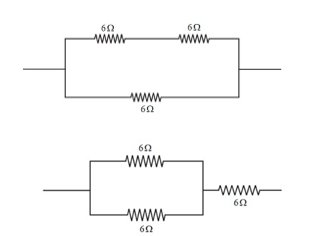
Similarly, if two resistors are connected in series and one is in parallel the equivalent resistance becomes 4 Ω.
Question 12: Several electric bulbs designed to be used on a 220 V electric supply line, are rated 10 W. How many lamps can be connected in parallel with each other across the two wires of 220 V line if the maximum allowable current is 5 A?
Answer: For one bulb: Power P = 10 W and Potential difference V = 220 V

As the all resistors in parallel are similar, current divides equally among them.
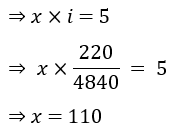
Therefore 110 bulbs in parallel are required to draw a current of 5 A on 220 V line.
Question 13: A hot plate of an electric oven connected to a 220 V line has two resistance coils A and B, each of 24 Ω resistance, which may be used separately, in series, or in parallel. What are the currents in the three cases?
Answer: Case 1: When resistance 24 Ω is only used,
From Ohm’s law,
V = IR

Current 9.17 A flows when resistors are used separately.
Case 2: When resistors are used in series combination,
From Ohm’s law, V = IR

Current 4.58 A flows when resistors are used in series combination
Case 3: When resistors are used in parallel combination,
From Ohm’s law,
V = IR

Current 18.33 A flows when resistors are used in parallel combination.
Question 14: Compare the power used in the 2 Ω resistor in each of the following circuits:
(i) a 6 V battery in series with 1 Ω and 2 Ω resistors, and
(ii) a 4 V battery in parallel with 12 Ω and 2 Ω resistors.
Answer: Potential difference, V = 6 V
(i) 1 Ω and 2 Ω resistors are connected in series. So, the equivalent resistance of the circuit,
R = 1 + 2 = 3Ω

In series combination, the current in the circuit remains the same.
Therefore, Power, P = I2R = 22 × 2 = 8W
(ii) 12 Ω and 2 Ω resistors are connected in parallel.
In parallel combination the voltage in the circuit remains same.
Now, we can calculate the power consumed by the resistor 2 Ω as follows:

Hence, in both case Power remain same as 8 W.
Question 15: Two lamps, one rated 100 W at 220 V, and the other 60 W at 220 V, are connected in parallel to the electric mains supply. What current is drawn from the line if the supply voltage is 220 V?
Answer: For the lamp one:
Power P1 = 100 W and Potential difference V = 220 V

For the lamp two:
Power P2 = 60 W and Potential difference V = 220 V

So, the net current drawn from the supply is given by
I = I1+I2
= 0.455 + 0.273
= 0.728 A
Question 16: Which uses more energy, a 250 W TV set in 1 hr, or a 1200 W toaster in 10 minutes?
Answer: Energy consumed by an electrical appliance is given by H = Pt
Power rating of TV set is 250 W
Energy consumed by TV set 1 hour = 250 × 60 × 60 = 900000 J
Power rating of toaster is 1200 W
Energy consumed by toaster in 10 minutes = 1200 × 10 × 60 =720000 J
Hence, TV set uses more energy than toaster.
Question 17: An electric heater of resistance 8 Ω draws 15 A from the service mains 2 hours. Calculate the rate at which heat is developed in the heater.
Answer: Given: Current I = 15 A
Resistance R = 8 Ω
Time 𝑡 = 2 hours
The rate at which heat is developed is given by

Question 18: Explain the following.
(a) Why is the tungsten used almost exclusively for filament of electric lamps?
(b) Why are the conductors of electric heating devices, such as bread-toasters and electric irons, made of an alloy rather than a pure metal?
(c) Why is the series arrangement is not used for domestic circuits?
(d) How does the resistance of a wire vary with its area of cross-section?
(e) Why are copper and aluminium wires usually employed for electricity transmission?
Answer: (a) Melting point and resistivity of tungsten are very high. Bulbs give light at very high temperatures, and tungsten is the best material to withstand such high temperatures.
(b) Resistivity of alloy is more compared to resistivity of a pure metal. Thus, conductors of electric heating devices such as bread-toasters and electric irons made of an alloy rather than a pure metal.
(c) In series connection, if one circuit element gets damaged circuit breaks at that point and rest of the elements doesn’t work. Moreover, in series connection voltage distributes among the circuit elements and each element doesn’t get appropriate voltage to work.
(d) Resistance (𝑅) of a wire is inversely proportional its area of cross-section(A)

Resistivity of copper and aluminium wires are very low and heat generated in them while passing current is very less. Thus, copper and aluminium wires are usually employed for electric transmission.